https://www.meritnation.com/ask-answer/question/what-is-nervous-system/tissues/6793111
- 0
divisions of the nervous system
 table of contents
table of contents
Neuroanatomy: the structure of the nervous system. To learn how the nervous system functions, you must learn how the nervous system is put together.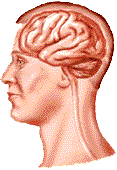
The nervous system can be divided into several connected systems that function together. Let's start with a simple division:
The nervous system is divided into the central nervous systemand peripheral nervous system.
Let's break the central nervous system and the peripheral nervous system into more parts.
Central Nervous System
 The central nervous system is divided into two parts: thebrain and the spinal cord. The average
The central nervous system is divided into two parts: thebrain and the spinal cord. The average adult human brain weighs 1.3 to 1.4 kg (approximately 3 pounds). The brain contains about 100 billion nerve cells (neurons) and trillons of "support cells" called glia. The spinal cord is about 43 cm long in adult women and 45 cm long in adult men and weighs about 35-40 grams. The vertebral column, the collection of bones (back bone) that houses the spinal cord, is about 70 cm long. Therefore, the spinal cord is much shorter than the vertebral column.
adult human brain weighs 1.3 to 1.4 kg (approximately 3 pounds). The brain contains about 100 billion nerve cells (neurons) and trillons of "support cells" called glia. The spinal cord is about 43 cm long in adult women and 45 cm long in adult men and weighs about 35-40 grams. The vertebral column, the collection of bones (back bone) that houses the spinal cord, is about 70 cm long. Therefore, the spinal cord is much shorter than the vertebral column.
For brain weights of other animals, see brain facts and figures.
Did you know? 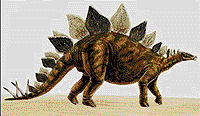 | A stegosaurus dinosaur weighed approximately 1,600 kg but had a brain that weighed only approximately 70 grams (0.07 kg). Therefore, the brain was only 0.004% of its total body weight. In contrast, an adult human weighs approximately 70 kg and has a brain that weighs approximately 1.4 kg. Therefore, the human brain is about 2% of the total body weight. This makes the brain to body ratio of the human 500 times greater than that of the stegosaurus. See "My Brain is Bigger than Your Brain" for more about brain size. |
Peripheral Nervous System
The peripheral nervous system is divided into two major parts: the somatic nervous system and the autonomic nervous system.
Somatic Nervous System
![[somaticnnervous system]](http://faculty.washington.edu/chudler/gif/somns.gif) The somatic nervous system consists of peripheral nerve fibers that send sensory information to the central nervous system AND motor nerve fibers that project to skeletal muscle.
The somatic nervous system consists of peripheral nerve fibers that send sensory information to the central nervous system AND motor nerve fibers that project to skeletal muscle.
The picture on the left shows the somatic motor system. The cell body is located in either the brain or spinal cord and projects directly to a skeletal muscle.
Autonomic Nervous System
 The autonomic nervous system is divided into three parts: the sympathetic nervous system, the parasympathetic nervous system and the enteric nervous system. The autonomic nervous system controls smooth muscle of the viscera (internal organs) and glands.
The autonomic nervous system is divided into three parts: the sympathetic nervous system, the parasympathetic nervous system and the enteric nervous system. The autonomic nervous system controls smooth muscle of the viscera (internal organs) and glands.
This picture shows the general organization of the autonomic nervous system. The preganglionic neuron is located in either the brain or the spinal cord. This preganglionic neuron projects to an autonomic ganglion. The postganglionic neuron then projects to the target organ. Notice that the somatic nervous system has only one neuron between the central nervous system and the target organ while the autonomic nervous system uses two neurons.
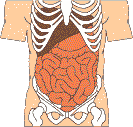
The enteric nervous system is a third division of the autonomic nervous system that you do not hear much about. The enteric nervous system is a meshwork of nerve fibers that innervate the viscera (gastrointestinal tract, pancreas, gall bladder).
The following table shows how the nervous system can be divided. The bottom row of the table contains the names of specific areas within the brain.

| Divisions of the Nervous System | ||
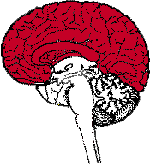 Telencephalon Telencephalon | 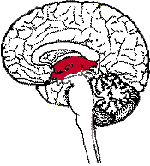 Diencephalon Diencephalon | 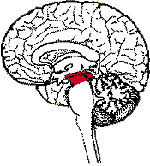 Mesencephalon Mesencephalon |
 Metencephalon Metencephalon | 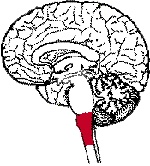 Myelencephalon Myelencephalon |
|
- 6
From a top view, notice how the brain is divided into two halves, called hemispheres. Each hemisphere communicates with the other through the corpus callosum, a bundle of nerve fibers. (Another smaller fiber bundle that connects the two hemispheres is called the anterior commissure).
Some differences between the peripheral nervous system (PNS) and the central nervous system (CNS):
- In the CNS, collections of neurons are called nuclei. In the PNS, collections of neurons are called ganglia.
- In the CNS, collections of axons are called tracts. In the PNS, collections of axons are called nerves.
In the peripheral nervous system, neurons can be functionally divided in three ways:
- Sensory (afferent) - carry information INTO the central nervous system from sense organs or motor (efferent) - carry information away from the central nervous system (for muscle control).
- Cranial - connects the brain with the periphery or spinal - connects the spinal cord with the periphery.
- Somatic - connects the skin or muscle with the central nervous system or visceral - connects the internal organs with the central nervous system.
Brain Structures
Cerebral Cortex
Functions:
- Thought
- Voluntary movement
- Language
- Reasoning
- Perception
The word "cortex" comes from the Latin word for "bark" (of a tree). This is because the cortex is a sheet of tissue that makes up the outer layer of the brain. The thickness of the cerebral cortex varies from 2 to 6 mm. The right and left sides of the cerebral cortex are connected by a thick band of nerve fibers called the "corpus callosum." In higher mammals such as humans, the cerebral cortex looks like it has many bumps and grooves. A bump or bulge on the cortex is called a gyrus (the plural of the word gyrus is "gyri") and a groove is called a sulcus (the plural of the word sulcus is "sulci"). Lower mammals, such as rats and mice, have very few gyri and sulci.
Cerebellum
 Functions:
Functions:
- Movement
- Balance
- Posture
The word "cerebellum" comes from the Latin word for "little brain." The cerebellum is located behind the brain stem. In some ways, the cerebellum is similar to the cerebral cortex: the cerebellum is divided into hemispheres and has a cortex that surrounds these hemispheres.
Brain stem
Functions:
- Breathing
- Heart Rate
- Blood Pressure
The brain stem is a general term for the area of the brain between the thalamus and spinal cord. Structures within the brain stem include the medulla, pons, tectum, reticular formation and tegmentum. Some of these areas are responsible for the most basic functions of life such as breathing, heart rate and blood pressure.
Hypothalamus
Functions:
- Body Temperature
- Emotions
- Hunger
- Thirst
- Circadian Rhythms
The hypothalamus is composed of several different areas and is located at the base of the brain. Although it is the size of only a pea (about 1/300 of the total brain weight), the hypothalamus is responsible for some very important functions. One important function of the hypothalamus is the control of body temperature. The hypothalamus acts as a "thermostat" by sensing changes in body temperature and then sending signals to adjust the temperature. For example, if you are too hot, the hypothalamus detects this and then sends a signal to expand the capillaries in your skin. This causes blood to be cooled faster. The hypothalamus also controls the pituitary.
Thalamus
Functions:
- Sensory processing
- Movement
The thalamus receives sensory information and relays this information to the cerebral cortex. The cerebral cortex also sends information to the thalamus which then transmits this information to other areas of the brain and spinal cord.
Limbic System
 Functions:
Functions:
- Emotions
- Memory
The limbic system (or the limbic areas) is a group of structures that includes the amygdala, the hippocampus, mammillary bodies and cingulate gyrus. These areas are important for controlling the emotional response to a given situation. The hippocampus is also important for memory.
Hippocampus
Functions:
- Learning
- Memory
The hippocampus is one part of the limbic system that is important for memory and learning.
Basal Ganglia
Functions:
- Movement
The basal ganglia are a group of structures, including the globus pallidus, caudate nucleus, subthalamic nucleus, putamen and substantia nigra, that are important in coordinating movement.
Midbrain
Functions:
- Vision
- Audition
- Eye Movement
- Body Movement
The midbrain includes structures such as the superior and inferior colliculi and red nucleus. There are several other areas also in the midbrain.
- 12


